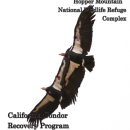Management and Conservation
Wildlife and Habitat Management
Hopper Mountain NWR was established in 1974 to provide safe roosting and foraging habitat for California condors and to protect other threatened and endangered species. Since its establishment, the Refuge has been closed to public use due to the sensitive nature of the California Condor Recovery Program activities, the sensitivity of its resources, and a lack of public access to the site. Vehicles are used regularly for condor management activities on the Refuge. All-terrain vehicles (ATV) and other motor vehicles such as pickup trucks are used for monitoring, tracking, feeding, and moving condors. Refuge staff use ATVs and hiking trails to access adjacent U.S. Forest Service lands and private property (with prior access agreements) to monitor condor nesting activity. At this time, condor monitoring activities are ongoing; however, no biological surveys are being done on the Refuge for other species.
Drinking water used for the Refuge staff is pumped from a natural spring on the Refuge by a solar powered water pump to a large above ground storage tank near the historic house and cabin. The natural spring also provides water for a water tank near the condor pen facility.
Fire Management
Fire preparedness is an important aspect of Refuge management. Fire management is currently limited to prevention or suppression. More information about the FWS fire team assigned to this area can be found on the Fire Management page.
Each year, prior to summer, a local fire department is contracted to remove vegetation around all structures. Fire crews create bare ground fire breaks around the main compound and the condor facility. Early in the spring when vegetation is beginning to sprout, the fire department ATVs with herbicide tanks with glyphosate herbicide to spray vegetation around all structures, reducing the amount of mowing required later in the summer. In total, approximately 15 acres of vegetation is cut or cleared around the structures on the Refuge. The main road is also occasionally graded as needed by the fire department using a road grader.
Oil and Gas Extraction Access
There are currently 3 oil well pads that contain producing wells and storage facilities on Refuge lands. The lessees of this property are permitted to use a 2-track road to access the land. Land may be accessed via truck or ATV year round, depending on road conditions. The use is limited to conducting oil and gas related work, and the lessees regularly meet with Refuge staff to keep each party informed of management activities and hunting season communication.
Cultural Resources Management
Very few archaeological surveys have been performed within the boundaries of Hopper Mountain NWR, so the potential for significant cultural resource sites is not clearly understood. Since its establishment in 1972, fieldwork on the Refuge has fallen into three categories:
1) Third parties fulfilling requirements to obtain conditional use permits for oil exploration;
2) Compliance with Section 106 of the National Historic Preservation Act (NHPA) for Refuge management and Recovery Program activities; and
3) Post-wildfire damage assessment. The total acreage surveyed as a result of these efforts is unknown, but it totals no more than 20 acres at most, less than 1% of the Refuge’s total acreage.
Comprehensive Conservation Plan
The purpose of a CCP is to specify a management direction for the Refuge for the next 15 years. Click here to view the CCP for Hopper Mountain NWR.
Law Enforcement
The National Wildlife Refuge System's Law Enforcement Division is responsible for physical security and emergency management on FWS lands. Refuge law enforcement officers have federal jurisdiction to enforce federal conservation laws throughout the United States.



